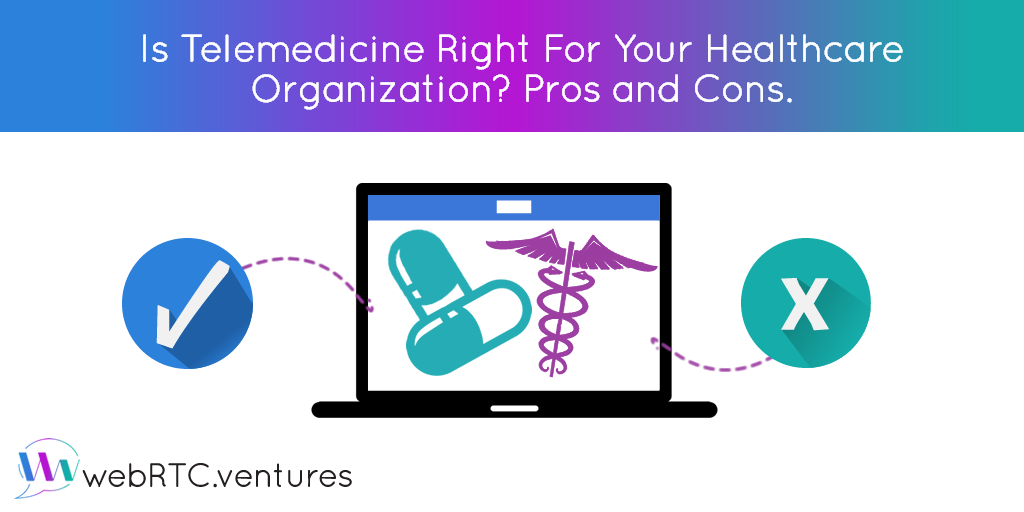Telemedicine has been gaining much attention lately due to the benefits it offers both patients and providers. Question: Is telemedicine right for your healthcare organization? Read on to learn a few of the pros and cons.
Pros.
Easier to Access.
Telemedicine closes the gap between patients and physicians. For patients- seeing a doctor can be just a matter of taking out a cell phone or tablet and clicking a link. No transportation costs and no waiting time. For providers- telemedicine offerings can attract more patients and therefore increase revenue.
Cost Savings.
Not only can patients benefit from lower costs but so can providers. Telemedicine helps to minimize non-urgent ER visits and is an effective way to reduce high hospital readmission rates.
Increase Coverage.
One of the greatest features of telemedicine is that it can overcome geographical barriers, this allows remote areas that aren’t well covered to get access to advanced services that normally wouldn’t be available in that region. A great example of this is how telemedicine has been implemented in Rwanda.
Compliance = Security & Privacy.
Worried about the security of the data in the telemedicine solution? Thanks to regulatory laws such as HIPAA patients and providers can be sure that the information will be securely stored and transmitted; thanks to the secure nature of WebRTC protocols, the same applies for the communication channels.
Improved Treatment Follow-up.
By using medical mobile and web apps, patients can get reminders and tips for treatments, this can be complemented with quick 5-10 min follow-ups calls to see if the medications are working and evaluate the evolution of the disease.
Cons.
Requires Proper Training and Equipment.
In order to get the most of telemedicine, physicians, nurses and all those involved in providing healthcare need to have proper training for using the equipment and technologies. Also, some of the software & hardware required can be expensive, but cost-saving in the long run.
It’s Not a One-size-fits-all Solution.
Telemedicine may not be suitable for all situations. It is best is to design a good implementation plan (more on that later) and place telemedicine where it fits. A good example of use cases include: initial consultation, follow-ups, remote assistance, mental health care, addiction therapy, diabetes care etc.
Regulations.
Regulatory laws of the actual practice of telemedicine varies state-to-state; so it is necessary to create valid doctor-patient relationship according to the law that applies. Patient’s geographical location, scope of physician’s license, and state and federal laws must be taken into consideration.
Technical Glitches.
As with any other kind of technology, there can be technical issues: poor connection, malfunctioning devices or software and hardware misuse, etc. Once again it is crucial to design of a good implementation plan that considers these flaws and defines “backup processes” when possible.
Change Resistance.
Telemedicine implies some practices and skills that go beyond the traditional healthcare, so some people might be hesitant to embrace something different than what they’re accustomed to. Part of a good implementation plan is to put the people in first: their worries, necessities and workflows in order to reduce the resistance to new things.
How to Overcome Challenges?
The key to overcome issues and be successful at embracing telemedicine is the design of a good implementation plan.
Here are some tips for building solid guidelines when applying telemedicine:
- Do not focus on the technology: Despite all the cool features that Telemedicine offers, do not consider it as the end in itself, but as a tool to achieve your own objectives and goals. Define what you want to accomplish, involve all the related actors and build a solid process – only then place the technology on top of what you’ve already built.
- Design something that works on-site: One way to ensure the success of a Telemedicine workflow, is making sure that it also works on on-site fashion. Don’t forget that the only difference between the two is the geographical location of the participants, everything else should apply for both approaches.
- Telemedicine does not replace on-site healthcare: The idea of telemedicine is to improve the traditional workflow, not to replace it. Patients still need to be admitted to hospitals and physicians still need to physically examine patients. Telemedicine provides some alternate methods to diagnose and follow-up and provides some advantages in some situations.
As you can see, Telemedicine is a great tool to expand the scope of healthcare services, however a good plan that consider its flaws and weakness is equally important in order to get a successful implementation.
Interested in learning more?
Click here to learn how a Telehealth WebRTC application can financially benefit your hospital, healthcare system or practice, read case studies and testimonials, and even see a Telehealth app in action.
Ready to Build your Telemedicine Application?
Let our experts at webRTC.ventures help you build your custom video and audio telemedicine app. We have decades of experience with over 200,000 hours invested in building real-time applications.
Contact us today. We’ll build your user-friendly, HIPAA-compliant app — designed with both the provider and patient in mind.











